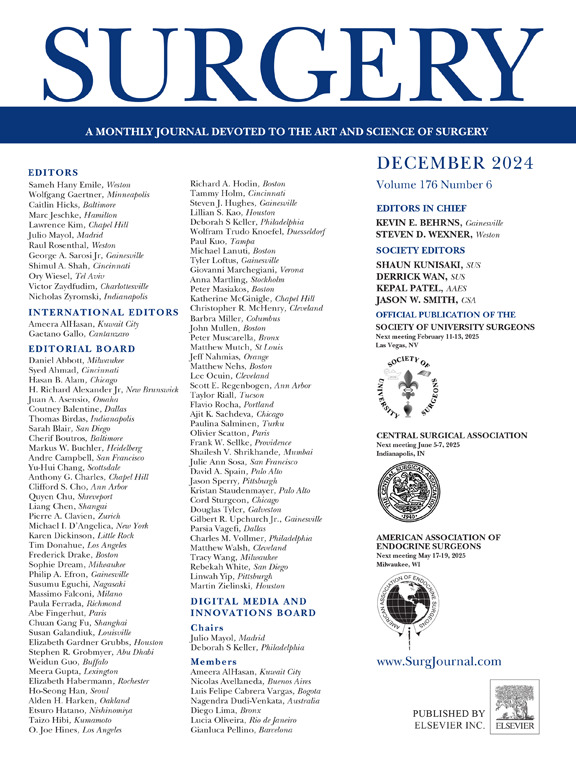Carcinoma sequence inferred from increasing age at choledochal cyst excision
IF 3.2
2区 医学
Q1 SURGERY
引用次数: 0
Abstract
Background
Choledochal cysts pose risk for biliary carcinoma, although age-related progression of biliary epithelial transformation remains uncharacterized. This study aimed to elucidate the carcinoma sequence within choledochal cysts across all patient ages to inform cancer risk and screening.
Methods
Patients treated either for choledochal cysts or biliary carcinoma at 1 institution (1988–2023) were analyzed. Choledochal cyst pathology was reviewed for biliary epithelial changes, whereas patients with biliary carcinoma were assessed for history of choledochal cysts. Descriptive statistics and logistic regression of age at epithelial change were performed.
Results
Among 130 patients with choledochal cysts, median age at resection was 12 years, female patients predominated (73%), and Asian race was 2.5-fold increased. Patients commonly presented with biliary obstruction, pancreatitis, and type I choledochal cysts. Cyst pathology revealed chronic inflammation (56.1%) and progressive epithelial transformation (6.9%): 3 metaplasia, 1 hyperplasia, 3 dysplasia, and 3 synchronous biliary carcinoma. Logistic regression showed positive association between increasing age at excision and progressive epithelial transformation (P = .038). One 6-year-old patient with choledochal cysts developed metachronous biliary carcinoma at age 37 years. Among 886 nonampullary patients with biliary carcinoma, 8 (0.9%) had choledochal cysts: 7 synchronous and the same metachronous. Resection of choledochal cysts after age 17 years showed increased odds for epithelial transformation (odds ratio, 15.0; P = .0093). Cumulatively, median age (years) increased from premalignant biliary epithelial transformation (34 [16–35]), to biliary carcinoma with choledochal cysts (51 [37–78]), to biliary carcinoma without choledochal cysts (65 [56–72]; P < .001).
Conclusion
These data infer sequential epithelial transformation to biliary carcinoma correlating with increasing age at resection of choledochal cysts. Coupled with 1 case of metachronous biliary carcinoma, this study underscores the need to screen patients with previous excision of choledochal cysts for cancer beginning at age 30 years.
从胆总管囊肿切除时年龄的增加推断出肿瘤序列
背景:胆总管囊肿有胆道癌的风险,尽管胆道上皮转化的年龄相关进展尚未明确。本研究旨在阐明所有年龄段患者胆总管囊肿内的癌序列,为癌症风险和筛查提供信息。方法分析1988-2023年收治的胆道囊肿或胆道癌患者的临床资料。回顾胆总管囊肿病理检查是否有胆道上皮改变,而胆道癌患者是否有胆总管囊肿病史。对上皮变化的年龄进行描述性统计和逻辑回归。结果130例胆总管囊肿患者中位年龄为12岁,女性患者占多数(73%),亚裔患者增加2.5倍。患者通常表现为胆道梗阻、胰腺炎和I型胆总管囊肿。囊肿病理显示慢性炎症(56.1%)和进行性上皮转化(6.9%):化生3例,增生1例,不典型增生3例,同步胆道癌3例。Logistic回归显示,年龄的增加与上皮细胞的进展性转化呈正相关(P = 0.038)。一名6岁的胆道囊肿患者在37岁时发生异时性胆道癌。在886例非壶腹胆道癌患者中,8例(0.9%)发生胆总管囊肿,7例同时发生,1例异时发生。17岁后切除胆总管囊肿显示上皮转化的几率增加(优势比,15.0;P = .0093)。累积起来,中位年龄(岁)从癌前胆道上皮转化(34岁[16-35])增加到胆道癌合并胆总管囊肿(51岁[37-78]),再到胆道癌合并胆总管囊肿(65岁[56-72]);P & lt;措施)。结论:这些数据推断,胆总管囊肿切除时,上皮向胆道癌的顺序转化与年龄的增加有关。再加上1例异时性胆道癌,这项研究强调了对30岁开始的胆道囊肿切除术患者进行癌症筛查的必要性。
本文章由计算机程序翻译,如有差异,请以英文原文为准。
求助全文
约1分钟内获得全文
求助全文
来源期刊

Surgery
医学-外科
CiteScore
5.40
自引率
5.30%
发文量
687
审稿时长
64 days
期刊介绍:
For 66 years, Surgery has published practical, authoritative information about procedures, clinical advances, and major trends shaping general surgery. Each issue features original scientific contributions and clinical reports. Peer-reviewed articles cover topics in oncology, trauma, gastrointestinal, vascular, and transplantation surgery. The journal also publishes papers from the meetings of its sponsoring societies, the Society of University Surgeons, the Central Surgical Association, and the American Association of Endocrine Surgeons.
 求助内容:
求助内容: 应助结果提醒方式:
应助结果提醒方式:


